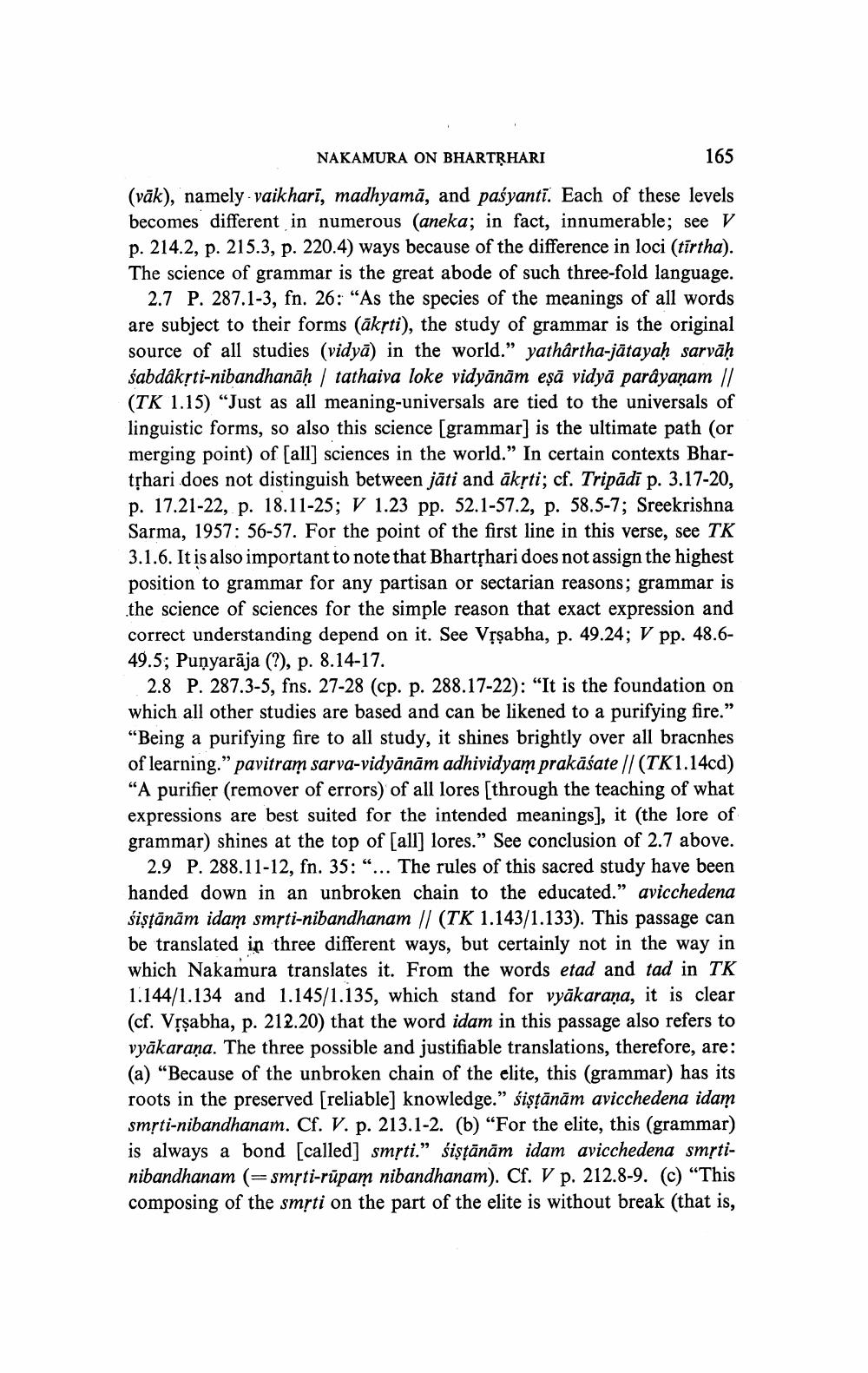Book Title: Nakamura On Bhartrhari Author(s): Ashok Aklujkar Publisher: Ashok Aklujkar View full book textPage 5
________________ NAKAMURA ON BHARTṚHARI 165 (vāk), namely vaikhari, madhyama, and pasyanti. Each of these levels becomes different in numerous (aneka; in fact, innumerable; see V p. 214.2, p. 215.3, p. 220.4) ways because of the difference in loci (tīrtha). The science of grammar is the great abode of such three-fold language. 2.7 P. 287.1-3, fn. 26: "As the species of the meanings of all words are subject to their forms (ākṛti), the study of grammar is the original source of all studies (vidya) in the world." yathârtha-jätayaḥ sarvāḥ sabdâkṛti-nibandhanāḥ | tathaiva loke vidyānām eṣā vidyā parâyaṇam || (TK 1.15) "Just as all meaning-universals are tied to the universals of linguistic forms, so also this science [grammar] is the ultimate path (or merging point) of [all] sciences in the world." In certain contexts Bhartṛhari does not distinguish between jāti and ākṛti; cf. Tripādī p. 3.17-20, p. 17.21-22, p. 18.11-25; V 1.23 pp. 52.1-57.2, p. 58.5-7; Sreekrishna Sarma, 1957: 56-57. For the point of the first line in this verse, see TK 3.1.6. It is also important to note that Bhartṛhari does not assign the highest position to grammar for any partisan or sectarian reasons; grammar is the science of sciences for the simple reason that exact expression and correct understanding depend on it. See Vṛṣabha, p. 49.24; V pp. 48.649.5; Punyarāja (?), p. 8.14-17. 2.8 P. 287.3-5, fns. 27-28 (cp. p. 288.17-22): "It is the foundation on which all other studies are based and can be likened to a purifying fire." "Being a purifying fire to all study, it shines brightly over all bracnhes of learning." pavitram sarva-vidyānām adhividyam prakāśate || (TK1.14cd) "A purifier (remover of errors) of all lores [through the teaching of what expressions are best suited for the intended meanings], it (the lore of grammar) shines at the top of [all] lores." See conclusion of 2.7 above. 2.9 P. 288.11-12, fn. 35: "... The rules of this sacred study have been handed down in an unbroken chain to the educated." avicchedena siṣṭānām idam smṛti-nibandhanam || (TK 1.143/1.133). This passage can be translated in three different ways, but certainly not in the way in which Nakamura translates it. From the words etad and tad in TK 1.144/1.134 and 1.145/1.135, which stand for vyakaraṇa, it is clear (cf. Vṛṣabha, p. 212.20) that the word idam in this passage also refers to vyākaraṇa. The three possible and justifiable translations, therefore, are: (a) "Because of the unbroken chain of the elite, this (grammar) has its roots in the preserved [reliable] knowledge." siṣṭānām avicchedena idam smṛti-nibandhanam. Cf. V. p. 213.1-2. (b) "For the elite, this (grammar) is always a bond [called] smrti." siṣṭānām idam avicchedena smrtinibandhanam (=smṛti-rupam nibandhanam). Cf. V p. 212.8-9. (c) "This composing of the smrti on the part of the elite is without break (that is,Page Navigation
1 ... 3 4 5 6 7 8 9 10 11 12 13 14 15
